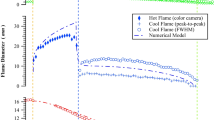Abstract
We present the results of theoretical and numerical research on the burning of spherical thermonuclear targets under conditions where the peripheral part of the deuterium–tritium plasma is mixed with the surrounding inert substance of the target ablator; this takes place as a result of the development of hydrodynamic instabilities during the process of compression under the laser-pulse action. We investigate targets with parameters corresponding to the irradiation conditions given by the Russian Project on Megajoule Facility with an energy of about 2 MJ. For the investigated class of targets conforming to a large part of the evaporated ablator substance (no less than 75% of its initial mass), we show that the mixing does not spread to the region of strongly compressed fuel, which introduces a determining contribution to the propagation of the burning wave, not to speak of the central part of hot plasma responsible for the initiation of the burning wave. For this reason, the negative effect of the mixing on the burning efficiency of such targets is insignificant, and, as compared with the target burn in the absence of mixing, the released fusion energy decreased by no more than 20%.
Similar content being viewed by others
References
Yu. V. Afanas’ev, N. G. Basov, P. P. Volosevich, et al., in: Proceedings Fifth IAEA Conference (Tokyo, 11–15 November 1974), IAEA, Vienna (1975), Vol. 2, p. 559.
Yu. V. Afanas’ev, N. G. Basov, P. P. Volosevich, et al., JETP Lett., 21, 150 (1975).
V. B. Rozanov, C. P. Verdon, M. Decroisette, et al., “Inertial confinement target physics,” in: Energy from Inertial Fusion, IAEA, Vienna (1995).
S. Atzeni and J. Meyer-ter-Vehn, The Physics of Inertial Fusion, Oxford University Press (2004).
G. Taylor, Proc. R. Soc. London, Ser. A, Math. Phys. Sci., 201, 192 (1950).
H. Helmholtz, Sitz. Acad. Wiss. Berlin, 3, 647 (1888).
M. J. Edwards, P. K. Patel, and J. D. Lindl, Phys. Plasmas, 20, 070501 (2013).
O. A. Hurricane, D. A. Callahan, D. T. Casey, et al., Nature, 506, 343 (2014).
D. S. Clark, C. R. Weber, J. L. Milovich, et al., Phys. Plasmas, 23, 056302 (2015).
S. Yu. Gus’kov, D. V. Il’in, and V. E. Sherman, Plasma Phys. Rep., 37, 1020 (2011).
S. A. Bel’kov, S. V. Bondarenko, G. A. Vergunova, et al., J. Exp. Theor. Phys., 121, 686 (2015).
S. G. Garanin, Phys. Uspekhi, 54, 415 (2011).
N. V. Zmitrenko, V. Ya. Karpov, A. P. Fadeev, et al., Vopr. Atom. Nauki Tekh., Ser.: Metod. Programm. Chislennogo Resheniya Zadach Mat. Fiz., 2, 38 (1982) [in Russian].
V. B. Rozanov and N. N. Demchenko, Quantum Electron., 12, 1895 (1985).
N. N. Demchenko, I. Ya. Doskoch, S. Yu. Gus’kov, et al., Laser Part. Beams, 33, 4, 655 (2015).
S. Yu. Gus’kov, D. V. Il’in, A. A. Levkovsky, et al., Laser Part. Beams, 16, 11129 (1998).
H. Takabe, K. Mima, L. Montierth, and R. L. Morse, Phys. Fluids, 28, 3676 (1985).
Yu. V. Afanas’ev and S. Yu. Gus’kov, in: G. Velarde, Y. Ronen, and J. M. Mart´ınez-Val (Eds.), Nuclear Fusion by Inertial Confinement, CRC Press (1993), p. 99.
E. Fermi and J. von Neumann, “Taylor instability at the boundary of two incompressible liquids,” in: Part 2 of Document AECU-2979 (August 19, 1953).
S. W. Haan, Phys. Rev. A, 3, 5812 (1982).
D. L. Youngs, Physics D, 12, 32 (1984).
Author information
Authors and Affiliations
Corresponding author
Rights and permissions
About this article
Cite this article
Gus’kov, S.Y., Demchenko, N.N., Zmitrenko, N.V. et al. Effect of Mixing at the Fuel–Ablator Interface on the Burning of Inertial Confinement Fusion Targets Upon Direct Irradiation with a Megajoule Laser Pulse. J Russ Laser Res 38, 173–184 (2017). https://doi.org/10.1007/s10946-017-9631-y
Received:
Published:
Issue Date:
DOI: https://doi.org/10.1007/s10946-017-9631-y




